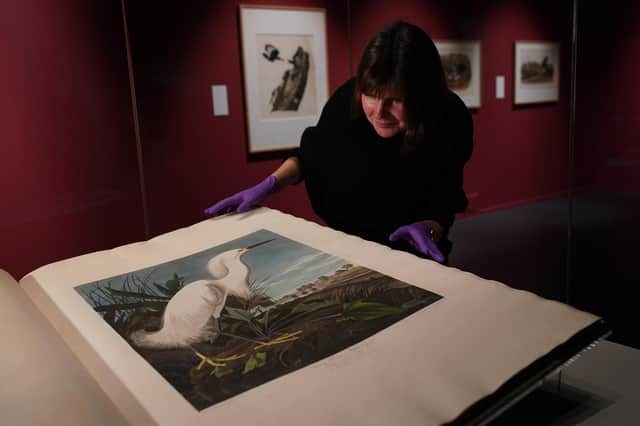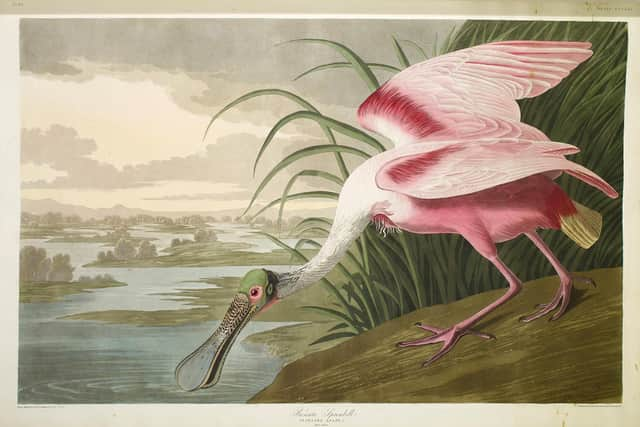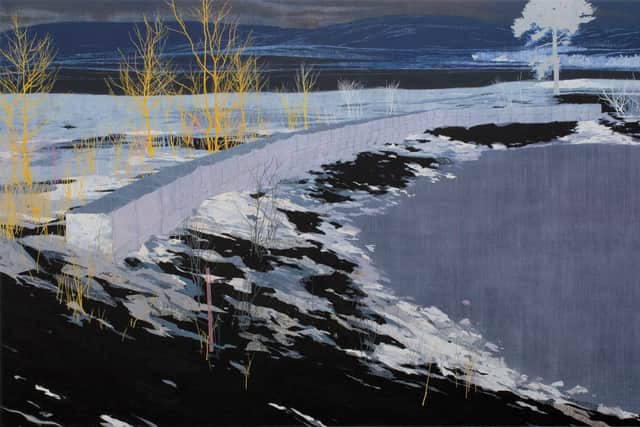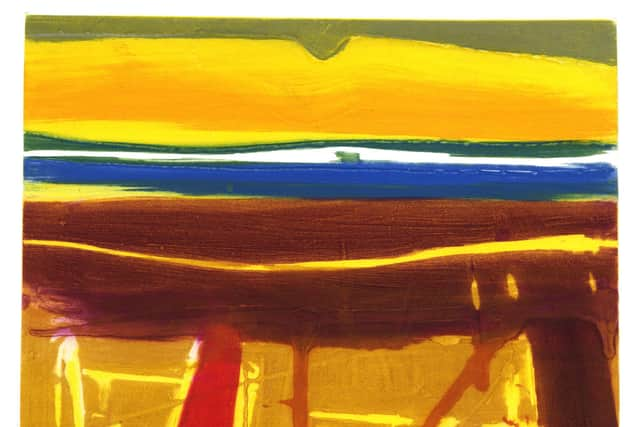Art reviews: Audubon’s Birds of America | Andrew Mackenzie | GPS Showcase


Andrew Mackenzie: Dusk, &Gallery ****
Showcase, Glasgow Print Studio ****


JJ Audubon is famous as the author of Birds of America. One of the most beautiful illustrated books ever printed and certainly now one of the most expensive, it was published in four parts between 1827 and 1839 and illustrates 497 species of birds on 435 plates. It must also be one of the largest books ever printed. The paper sheet size is called double elephant and measures 99 by 66 centimetres. For all its sophistication, the most familiar portrait of the author of this masterwork shows him very much as a wild frontiersman. Carrying a gun, he has long hair (dressed literally with bear’s grease we are told) and he is wearing a wolfskin coat. This picture was not painted in the Wild West by some intrepid travelling artist however, but in Edinburgh by John Syme who had been Raeburn’s assistant. The sitter liked his image of a man from the wild west.
Advertisement
Hide AdEdinburgh played a significant part in Audubon’s story and that is the cue for Audubon’s Birds of America at the National Museum. The picture of Audubon as a frontiersman was not entirely a fiction however. Born in Haiti and French by birth (he was christened Jean-Jacques) he spent much of his childhood France, but his father had interests in America and when he turned eighteen sent his son back there to avoid conscription into Napoleon’s army. Thereafter Audubon had various business ventures which took him further and further into the west. He had had a passionate interest in birds from childhood. It increasingly took over and he began to travel in search of new species to record in his drawings. Occasionally he stopped off to earn a bit of cash drawing portraits or giving lessons. In 1808 Alexander Wilson began to publish American Ornithology, a comprehensive catalogue of America’s birds. Audubon met Wilson (who was from Paisley) in 1810 and became convinced that he could do something much bigger and better than his book. Perhaps he wasn’t tactful enough in expressing that view. Certainly when he went to Philadelphia to try to launch his project in the US he was frozen out by Wilson’s friends and so in 1826 he crossed the Atlantic to find a publisher for his project and too to enrol the subscribers essential to a publication on the scale that he planned.
He landed in Liverpool in October and went straight to Edinburgh. He wanted to meet Walter Scott and intended to stay for just a week, but his welcome from the city’s cognoscenti was so warm and encouraging that he stayed five months. He held an exhibition of his works in the Royal Institution, the building that, much enlarged, is now the RSA. He was elected to the Royal Society of Edinburgh and to the Wernerian Natural History Society. His breakthrough came however when William Lizars, the leading engraver of the day and producer of some of the finest medical books, first saw Audubon’s drawings and declared “My god, I never saw anything like this before!”
Lizars offered to engrave and publish Audubon’s pictures. Work began and the first ten plates were completed, but then a strike by Lizars’s colourists brought it to an end. Audubon had to look elsewhere and settled for engravers Robert Havell, father and son, in London. The prints were engraved by Robert Havell junior, but he also used aquatint with great skill to add tonal depth. The engraved pictures were then coloured by hand. The work proceeded over the next eleven years and was published in four volumes. To avoid handing over valuable copies to the British copyright libraries, Audubon published his pictures without text so technically they were not printed books. Text was provided in a separate book titled Ornithological Biography. Scientific descriptions were written by William MacGillivray and Audubon added lively and often entertaining commentaries. Both MacGillivray’s and Audubon’s words are frequently used in the labels here.


But the prints themselves outshine all of this history and dominate the show. They are from an incomplete lapsed subscription, as well as individual prints from complete sets broken up and sold separately. All are strikingly beautiful. Audubon never used stuffed birds. He had no compunction about shooting his subjects. He then pinned their sad corpses onto a frame in attitudes that he had observed. He also insisted that in the engravings the birds should be presented life-sized, hence the enormous page size. Even so, this did present problems. Presented running, the relatively earthbound wild turkey does just fit on the page presented horizontally, but the bigger more aerial birds are not so easy to deal with. To fit it into the page, the golden eagle, although it is carrying a mountain hare in its talons, is apparently flying with its wings closed.
Nevertheless, as in this one, the plates are frequently vivid with action. In one dramatic picture, for instance, two red-tailed hawks are fighting in mid-air over a hare, (though again with their wings closed.) Still alive, the poor hare’s terror is vividly conveyed. Audubon was also concerned that the vegetation and other aspects of the birds’ settings should be authentic. One of the finest prints is of two snowy owls seen against a night sky. In his grasp of the interdependence of the birds and their habitat, Audubon was ahead of his time and although he happily shot a hundred birds a day, he recognised the threat that the ruthless destruction of habitat posed to all living things. ‘Nature herself is perishing’ he wrote after witnessing commercial egg harvesters decimating bird nests in Labrador. He was not just a major artist he was also a pioneer ecologist.
In Dusk at the &Gallery, Andrew Mackenzie’s beautiful contemplative pictures are perhaps not overtly ecological. On the face of it they are straightforward landscapes of trees skies and water, but then you notice there are other things going on. Sometimes the trees are in negative, as halfway to a photograph. Often the tonality of the whole picture suggests newsprint and if you look closely there is the suggestion of a grid in the paint. But in all of them, except it seems a group of very atmospheric pastels, there is also a skeletal structure of geometric lines hinting at architecture, or perhaps perspective, but either way at the human presence, or perhaps better human viewpoint which is after all inextricably part of any picture. The effect is poetic and contemplative, but it is not simple. It approaches ecology because its raises questions about our attitude of mind.
Advertisement
Hide AdFinally Showcase at Glasgow Print Studio brings together work from right across the Studio’s stable of artists past and present. Elizabeth Blackadder, John Houston, Eduardo Paolozzi, Philip Reeves, Alasdair Gray and Steven Campbell are historical figures now, but the tradition carries on with John Byrne, Ken Currie, Adrian Wisniewski Kenny Hunter, Toby Paterson, Jim Lambie. Not all their geese are swans, but there is enough in the output of the Studio’s artists to make a really creditable show.


Audubon’s Birds of America until 8 May; Andrew Mackenzie: Dusk until 2 March; Showcase, Glasgow Print Studio, until 26 March
A message from the Editor:
Advertisement
Hide AdThank you for reading this article. We're more reliant on your support than ever as the shift in consumer habits brought about by coronavirus impacts our advertisers.
If you haven't already, please consider supporting our trusted, fact-checked journalism by taking out a digital subscription at https://www.scotsman.com/subscriptions